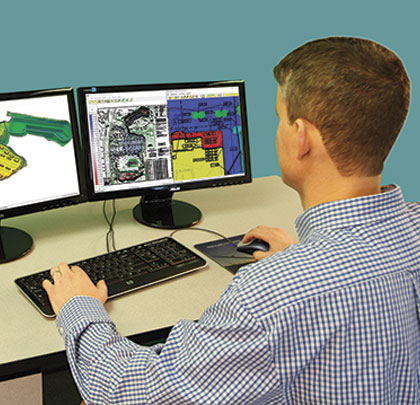The construction industry has become more complex and technologically sophisticated. Gone are the days when a smart owner/operator and his backhoe could handle most projects. Back then, measurements were close approximations and quality was achieved through the skills and experience of the hired contractor.
Today, contractors and project owners expect more. Speed, exacting accuracy, productivity, and quality long-life results are the expectation. Construction machines are more technologically advanced and sophisticated software creates project plans, manages the work, and documents the results.
TRAINING INVESTMENT
Software is at the heart of earthwork and utility estimating. It performs sitework take-off features that include calculating cut and fill, stripping, strata quantities, paving and concrete materials, topsoil re-spread, areas, lengths, trench excavation, and backfill.
“Proper utilization of software assures accurate results, increases productivity, and assures full benefits of the software,” states Steve Warfle, product manager for InSite Software Inc. “Many years ago, we recognized that having great features in our software don’t always guarantee they will be used.”
Training software users has proven to be beneficial for getting the most out of the investment. The American Society for Training and Development (ASTD) makes a compelling case for training in general. It is not unreasonable to see the benefits to construction industry software training.
ASTD recently conducted a study of more than 2,500 companies to determine how training investments affected a firm’s total shareholder return. Using a sophisticated statistical model taking into account a wide variety of variables, ASTD found that training resulted in a significant improvement in shareholder return.
By providing the training, the companies in the study gave their employees the tools they needed to become more productive. Additionally, the ASTD surveyed companies cited these benefits as well:
- Increased profitability
- Consistent quality
- Improved customer satisfaction
- Employee development
- Better employee retention
Unfortunately, training manuals and videos, newsletters and e-blasts are all great resources for learning new software and tools, but they all require the end user to find time to help themselves. Plenty of well-intentioned learning goals go unrealized because “my schedule got too busy,” “I’m planning to work on it next week,” or “I’ve got more important priorities to take care of right now, I’ll get to it later.”
“The human mind is superb at rationalizing reasons to delay self-initiated learning, which is why we favor classes that foster Interaction between students and a knowledgeable Instructor,” Warfle says. “With a scheduled training class, a time is set aside for learning and nothing else. This forces the student to set aside time strictly for learning.
“Many years ago we held regional training classes. They were good, but weren’t always available when a contractor needed them; plus they required an employee to travel, which meant time and cost.”
Warfle and his colleagues at InSite Software could see the benefits of training for their students but needed a better training and information delivery vehicle.
ONLINE TRAINING PROGRAMS
What they developed is a real-time, online training program, which can provide classes frequently and in progressive sequence from beginner level through advanced content mastery. What they are after is for their students to increase their knowledge, skills, and comfort with the capabilities of their software. The thinking is that a well-designed training program provides the most efficient way (least amount of time) to immediately achieve the maximum benefits of the software. Continued training can introduce the end user to advanced features, which can increase an employee’s capability and value.
“Purchasing technology and then not using it to its potential is expensive,” says Tara O’Neill, director of training for InSite Software Inc. “It’s amazing to hear long-term users take a training class for the first time and exclaim ‘I didn’t know it could do that!’”
Training on any kind of construction software is intended to help the users develop the skills to effectively apply the software to their need or challenge. It is the base knowledge that training provides that gives users the know-how and confidence to take control and manage their own projects.
It helps when those being trained don’t confuse technical support with training. “My CAD file won’t open!” is a tech support issue; whereas, “How do I import a CAD file?” is a training question. The difference between the two can be subjective and difficult to define. If a support question has to be answered time and time again for the same company, the question is no longer a support issue, but rather one of training for that company’s personnel.
A dual monitor training setup can help facilitate learning. With the setup, one of the student’s monitors is used to view the instructor’s screen. The other monitor is used to complete the exercises shown by mimicking the instruction. The instructor can also see the student’s progress and take over if necessary to correct or clarify their work on screen. The dual monitor arrangement allows both the student and trainer to interact throughout the class and creates hands-on participation, rather than a lecture style class.
“Respected construction software instructors have field experience and know how to apply the software to real-world needs and problems,” O’Neill says. “Knowing the subject matter is very important, but helping students to be comfortable with the skills they are learning and discuss how they could be applied to their own projects after training is critical.”
CONCLUSION
Clearly, software investments are necessary to be competitive and successful. Wise construction contractors realize that employee wages are often a far more significant expense. The logic follows that much like an investment in a new piece of construction equipment, the benefits of increased productivity come when the operator knows the machine … and the software. ■
About the Author: Jeff Winke is a business and construction writer based in Milwaukee, Wisconsin. He can be reached through jeff_winke@yahoo.com.
_________________________________________________________________________
Modern Contractor Solutions, May 2017
Did you enjoy this article?
Subscribe to the FREE Digital Edition of Modern Contractor Solutions magazine.



